Art Curator Charlotte Brooks reveals how artists bring a wealth of knowledge to each piece of botanical art
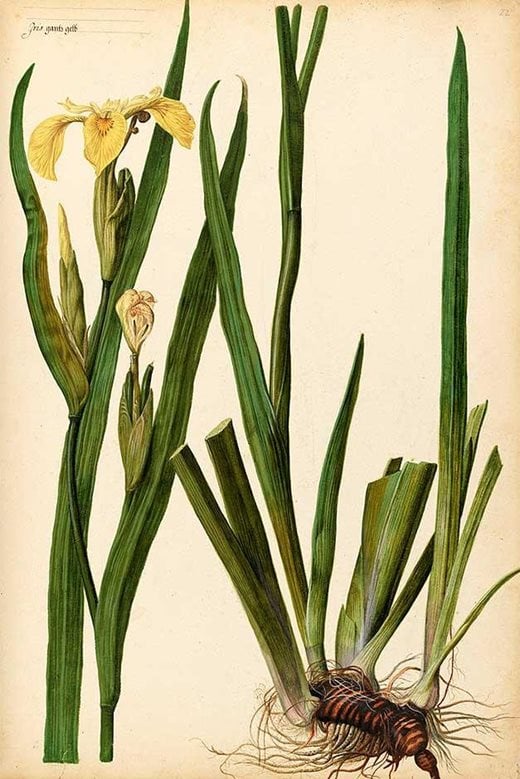 The ability to look, closely observe and then to know what it is you are seeing is critical for any botanical artist. However, it is not just the observation of the plant itself that is important, but an appreciation of how to then translate that into an image on the page.
The ability to look, closely observe and then to know what it is you are seeing is critical for any botanical artist. However, it is not just the observation of the plant itself that is important, but an appreciation of how to then translate that into an image on the page.
Being able to read and interpret another artists’ work can provide valuable insights and the paintings in the Lindley Library offer inspiration to both the keen amateur and established professional artist.
A wealth of expertise can be found in our art collection which represents nearly 400 years of botanical illustration, with the regular addition of new gold medal standard works from across the world. The work of revered Masters can be seen alongside the re-interpretation of traditional approaches by contemporary artists.
Whether it is a question of composition, the treatment of life-cycle stages or having the opportunity to see how a number of different artists tackled the same subject, immersing yourself in the work of others can help provide the stimulation to take a painting forwards.
Scale
One challenge faced by an amateur artist who was keen to paint the irises in his garden, was how best to ‘fit it all on the page’. Having previously been advised that the illustration should - if at all possible - be life size, he asked how this might be achieved when the plant in question came up to his shoulder? My ill-explained response did nothing to alleviate his anxiety, as I suggested with the picture he could ‘cut’ the iris and present the two halves side by side. He looked at me askance. I had meant to explain that he could metaphorically cut the iris - convention dictates this is an acceptable way of displaying very long or large specimens. However it took several minutes before he would be convinced I was not advocating the decapitation of his cherished blooms. Instead it was with examples of other artists’ work that I was able to demonstrate how this can be achieved with subtlety and grace. Pieter van Kouwenhoorn, painting in Holland in the 1630s, (see above) offers us one of the earliest examples of such treatment.
Colour
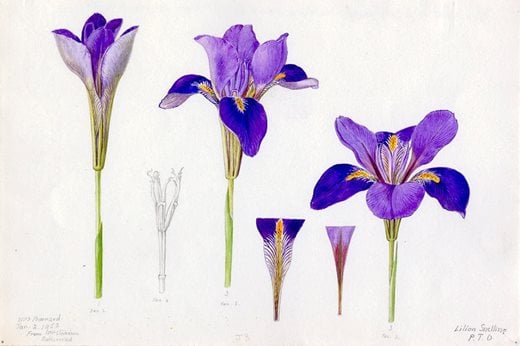 By comparison Lilian Snelling was tasked by the Society with depicting Iris ‘Mary Barnard’ over a four day period from 1-4 January 1952. Reproduced several years later in the Journal of the Royal Horticultural Society, her linear composition gives the impression of a time-lapse image, demonstrating how the flower opened over that period.
By comparison Lilian Snelling was tasked by the Society with depicting Iris ‘Mary Barnard’ over a four day period from 1-4 January 1952. Reproduced several years later in the Journal of the Royal Horticultural Society, her linear composition gives the impression of a time-lapse image, demonstrating how the flower opened over that period.
For all Snelling’s skill and expertise in botanical illustration (she enjoyed a long and illustrious career), it is reassuring to read her complaints to the editor that ‘Irises make terrible sitters! They fade so quickly and the true depth of colour is very hard to capture'.
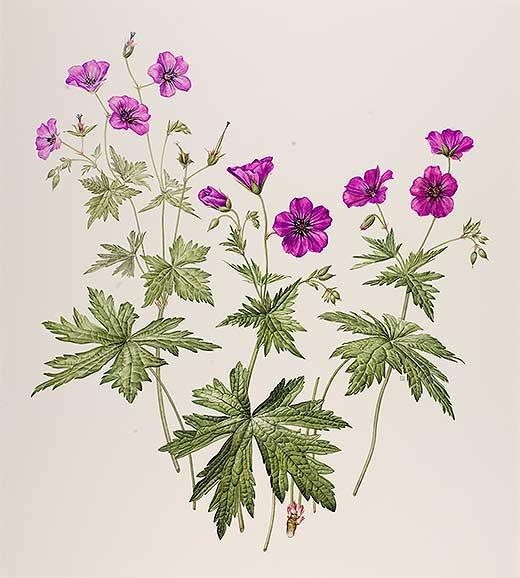 The personal notes, experiments with colour and observations
The personal notes, experiments with colour and observations
are fascinating and exceedingly valuable to those seeking encouragement. One of the ways in which the collection is being developed, is in the acquisition of working sketches and preliminary drawings. This added dimension reveals just how much work goes into creating a finished picture. One of the greatest challenges an artist faces is identifying the best colours to use to accurately represent the greens of leaves and stems, as well as the petals. If the piece in question is then to be published or reproduced, the scope for potential difficulty increases further.
Laura Silburn allowed the Library to acquire the preliminary drawings for her gold medal winning watercolour of Geranium ‘Patricia’. Here not only is the challenge to achieve the full depth of colour in the foreground flowerheads, but to create a subtle echo of that colour in the distance. Many hours spent experimenting with different combinations have resulted in a likeness that is exquisitely captured.
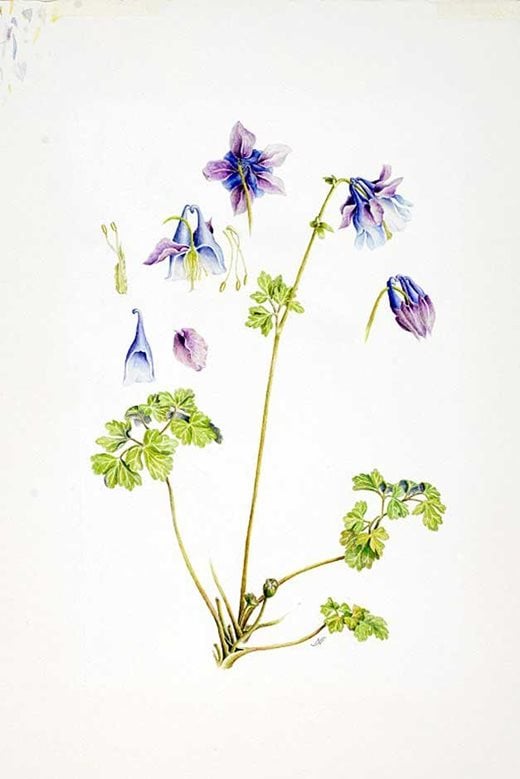 Niki Simpson trained as a botanist and artist and as such she undertook commissions for the Society in the 1990s. She is more recently known for her contributions to the advancement of digital botanical art, using a combination of photographic and illustrative techniques, for which she won RHS gold medals in 2007 and 2008.
Niki Simpson trained as a botanist and artist and as such she undertook commissions for the Society in the 1990s. She is more recently known for her contributions to the advancement of digital botanical art, using a combination of photographic and illustrative techniques, for which she won RHS gold medals in 2007 and 2008.
The Library holds an extensive collection of Niki’s work, which was recently augmented when she donated of number of her preliminary studies and ink drawings, to complement the finished watercolours. An example of the level of attention Niki pays to a specimen and how best to capture it in watercolour can be seen on the right. The gradation of colour required for each aspect of the flower head has been closely monitored and she records, ‘keep petals as pale’.
Technique
Each artist has their own way of developing a picture; and while some may paint rapidly, finishing a picture in several sittings, others have a more measured approach. For those artists painting a series of works for exhibtion, often working on several pieces simultaneously, each one represents hours and weeks of continuous work. Gael Sellwood (see below), with her recent award winning series of watercolours of ‘Autumn and Winter Hydrangeas’, described how she prepared eight paintings with a view to exhibiting only the best six with the RHS. Over a period of six months hydrangeas occupied all her attention with each painting taking between 70-90 hours to complete. She studied more than 40 flowerheads collected from a nursery in Cornwall to create the picture featured below, allowing her to make sure the composition, shading and texture were all perfectly captured. Gael won an RHS Gold medal and Best in Show at RHS Malvern Spring Festival 2014.
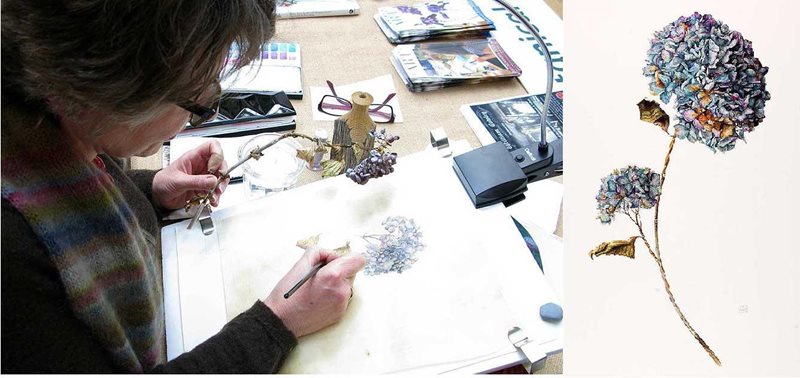
Rosalind Franklin also won an RHS Gold medal at RHS Malvern Spring Festival, 2015 for a series of paintings entitled ‘Arisaemas for the sheltered garden or greenhouse’. Her painting of Arisaema speciosum var. mirable was purchased for the Library art collections shortly afterwards. Ros kept meticulous records, photographing the processes involved in creating this picture. She carefully laid out and measured each element of the plant to build up the final composition and ensure the scale was consistent. The scaffolding served to support and protect the plant, maintaining its position for each sitting. The challenging composition here was critical to the success of the picture. The final layout includes all the requisite elements for a classic piece of botanical illustration, but with a contemporary twist. The extended spadix is developed as an artistic device and used to bring unity to the composition. Although it had not grown to this extent on Ros’ plant, it is not uncommon to see an extended spadix in the genus Arisaema, thus allowing her freedom to design her presentation whilst maintaining the botanical integrity of the genus.
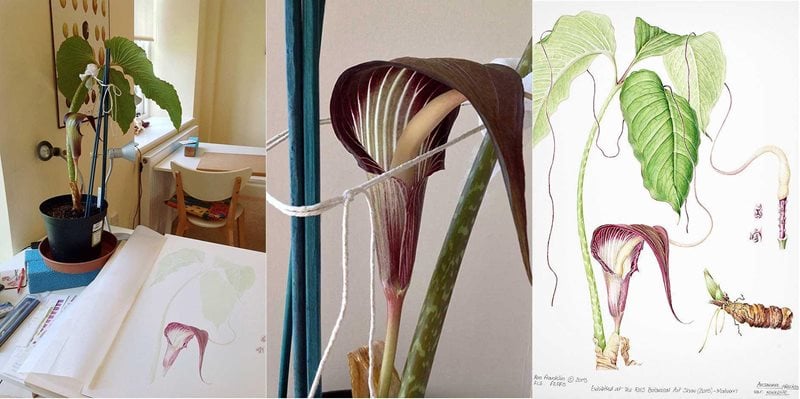
Each artist works in their own way, and photographs can be useful for providing additional source information as well as for documenting the progress of a painting. However, a piece of botanical art is much more than just a snapshot of a given plant, it is a carefully-constructed representation. The artist brings a wealth of knowledge to each new painting, not just in the technical accuracy demanded for capturing a plant, but also in creating an image that can be read and understood. A painting is rarely viewed in isolation and the influence of those artists who have gone before can often be seen in new works. The working sketches and colour experiments provided by some of the RHS Gold medal winning artists offer us a rare glimpse into their creative world - and develop a repository for future artists to call on.
More information
- Contact the Lindley Library London for appointments to view original artworks via [email protected].

